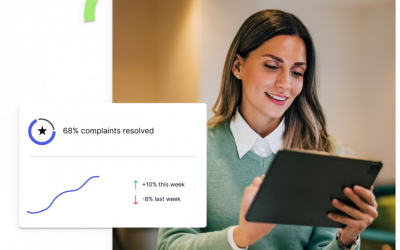Dan Schawbel of Workplace Intelligence, interviewed Chris Moore, our CEO and founder.
Their conversation explored the primary workplace challenges, and we delved into a step-by-step process on how to leverage people analytics data to tackle them effectively. They also explored how you need the combination of technology and people to improve workplace outcomes, the role of front-line managers and examples of companies that have used people data successfully.
1. As an industry veteran, what do you see as the biggest issues facing today’s workplace?
There are several post-pandemic issues that have come to the forefront. These include the varying dynamics and demands of returning to work as well as what it now takes to keep the evolving workforce engaged, skilled, and productive in this new hybrid and work-from-home model that has become the norm.
In addition, there continues to be an undercurrent of frustration that is tied directly to management not listening, being out of touch or solving the wrong problems causing disconnects and dissonance in their teams and business overall.
These struggles are leading to some very creative solutions such as the growth of the “skills economy” and subsequent talent marketplaces, where individual skills are mapped to specific business needs and project assignments are made, allowing workers to move between projects and, in some cases, even between companies. Communications are also at the forefront, as you now need to engage a remote workforce and keep them productive, accountable, and integrated into the fabric of your business, without the daily physical presence in the office you are accustomed.
How can you know that you are creating an environment where workers can be happy AND your business can benefit and grow/scale? How can you be sure that managers are adapting to the new workforce and dynamics and supporting their teams effectively? How can you know that what you did had the impact you hoped it would have on your people and your business overall?
The answer to many of these questions can be found in the effective identification, aggregation, organization, and management of relevant data tied to performance, employee engagement and overall business performance and outcomes. The regular review and analysis of the right data will surface trends, identify gaps, and help leadership quickly identify if they are on the right track or need to adjust to avoid tragic mistakes.
2. What is your 4-step process for leveraging people analytics data to address these workplace issues?
Step 1: Understand current state truth based on historical data/trends
Leveraging people analytics to address these and other workplace issues begins with the need for an accurate evaluation and view of the current state of people and the business. If you cannot accurately understand “what is”, it becomes impossible to implement the right changes that will move business forward.
Example: One global company had a top priority of creating more “great” talent within their workforce. What they lacked was a detailed and statistical understanding of “great” (What makes an employee great? What data do they have to help understand, identify, and benchmark great behaviors?). The initial step was to define the criteria and metrics to identify and measure exceptional talent throughout the organization, irrespective of their specific roles.
Step 2: Uncover gaps or outliers, changes, etc. (causation)
Once the current state is understood through the lens of trustworthy data, you can then search for gaps, outliers, and concerning trends.
Example: After working to define “great”, the above company determined that they had two main gaps — data that was not currently being collected and data that was being collected but was untrustworthy or difficult to access and distribute. The team updated processes, expanded the use of existing technology, and made a technology purchase (talent management system) to help support the capture of information around team performance, mentoring, volunteering, and lateral mobility. To address untrustworthy data making it accessible and meaningful to management/leadership, they started a project that looked to clean up the past 12 months of historical information while ensure that all new data that was collected was clean and accurate for things like succession measurement, engagement by individual, compa-ratios, independent learning, and mentoring.
Step 3: Design and implement change
As you prioritize the gaps or issues in Step 2 and work to put into place plans for mitigation and growth, it is time to look for meaningful and creative solutions to what has been discovered.
Example: Once they uncovered their gaps, the business was then able to look for specific employees who had high percentages of alignment to the criteria, those who were a tier below and those who needed development to move towards great. The business then planned and implemented programs that were designed to improve standing by providing additional experiences such as mentoring, cross team engagement in project work, rewards, and recognition for external or independent learning and development, etc.
Step 4: Define accountability, track impact, and adjust
When you provide a rubric-like framework in advance to your teams, you create an environment where everyone has clear expectations, accountability, and the highest likelihood of success. This phase of measurement requires ongoing communication and enablement (setting expectations, defining desired behaviors, providing tools and support) for all company stakeholders to ensure long standing success. This often overlooked, but paramount final step is an ongoing, living process that becomes woven into the fabric of healthy teams.
Example: Finally, the business provided managers and leadership with dashboards to track progress and adjusted as results started to come in, promoting/reinforcing the programs that had the most impact on moving employees upwards. In the end, they moved from what they determined was a 13% “great workforce” to 29% in just over a year (and still counting). The impact to revenue, profit margin, customer satisfaction and retention, new product development, etc. is both significant and growing every day.
At ZeroedIn we use our people analytics and data management solutions to engage seamlessly with our customers at any stage, helping them more effectively manage their talent operations.
3. Why is it important to not just focus on modern technology, but also people when trying to improve the employee experience, increase retention, and grow a business?
It is important to not just focus on technology because the key to any successful business is relationships and the ability to develop, maintain and deepen them across workers, teams, partners, and customers (present and future). Relationships require people at the core – they can be supported with, initiated by, or even grown with the assistance of technology, but people are, and will always be (this side of the Matrix!) the cornerstone.
That said, technology still does play a major role in employee enablement, performance measurement, process streamlining, providing methods for collecting and accessing information, and the elimination of repetitive and redundant task work. All of this serves to free up your people to focus on new solutions, creativity, engagement, interaction and, most of all, relationship-building.
It is this combination of people and technology that can truly transform our approach to work, how we go-to-market, and the ways in which you address needs and measure outcomes. That said, with more technology available and more coming online every day it, the issue isn’t always how to gain acceptance but rather to determine which mix of available technologies will best meet the needs of the business of today and, more importantly, for tomorrow. Couple this with the harm that can be done with a constant cycle of tech retirement, selection, enablement and integration and a workforce can become weary from the constant change of direction and lack of long-term stability.
One of the best ways to fix the evolving and potentially harmful cycle of technology implementation and retirement is to develop and enable a long-term, single source of truth that remains constant, while other solutions may come and go. This integration point for data and information will allow the business to support and measure change and will provide your workforce with a consistency that is paramount to acceptance and engagement.
4. Can you give examples of how people analytics can help organizations better utilize their talent?
It is essential that you find ways to turn the vast amounts of available information into an asset to drive effective decision-making. Far too often this information sits dormant, or worse, creates an avalanche of unactionable data that drives poor decision-making because of its very existence and the business’s inability to turn it into actionable and trustworthy insights.
With the proper information and insight, you can hire more effectively, improve performance, increase engagement and retention, understand risk of loss and reasons for voluntary leaving, create an effective and diverse workforce, notify teams about upward or downward trends, and even manage information as simple as headcount or compensation history to help streamline decisions and improve business operations and results.
Example: One municipality we work with at ZeroedIn is leveraging analytics to marry the city’s budget requirements to their talent acquisition and management strategy. This requires fingertip access to criteria such as hire date, salary, promotion history, people investment by department and across the entire organization, open requisitions, anticipated retirements and so much more. By providing this data in a dashboard that is drillable, it allows management and leaders to explore, scenario plan, and map expenses (real and projected) to the budget that is approved by the mayor’s office each cycle.
5. What advice do you have for organizations who are unsure of how they can get started?
To begin, your organization must want to utilize talent better from top to bottom. You must start thinking differently about talent because the talent is thinking differently about talent!
If your business has not prioritized investing in talent, then the place to begin is by developing a business case that demonstrates the value and impact that such an investment would have on bottom line revenue, improved profitability, customer retention, reduction of risk, etc. Such a business case would begin with an accurate understanding of the current state of business outcomes, then a conservative estimate on how these outcomes would be impacted by investing in people intentionally and effectively.
Based on an actual example, we supported one of our customers in building the following business case (simplified for use here): the average sales rep generates $750,000 in sales annually. This is without ongoing training, no mentoring and, because of the high turnover rate within sales (42%), our sales have been declining for the past 3 years. I believe if we invest $250k into the development of effective training, create embedded mentoring programs for all sales reps, and recognize growth along with hitting targets, we can improve retention by 15% or more, raise the average annual sales by $250,000 per employee and improve the bottom-line impact on our company revenue by over $4.2 million in the first three years.
However, if your business does prioritize investing in its people, then here are three steps to getting started:
Step 1: Create visibility and communicate the need to utilize data more effectively throughout all levels of the organization.
Data can be embedded into recurring meetings at all levels of the organization, reviewing where things were, what has been done and the impact and setting measurable targets looking ahead. You might even want to create a dashboard of key business metrics for all employees to view and/or explore based on their role and access.
Step 2: Get started with what you have, even if data is not present or trustworthy.
Data can be cleaned, reorganized, updated, and new data can be collected. Identify two to three key sources of data that are untrustworthy and start cleaning, aggregating, or consolidating so that you have a “trust-birth date” that will set the foundation for good data moving forward. Each quarter or year if needed, additional data sources can be addressed or developed to add to the cache if trustworthy data that you have access to daily.
Step 3: Develop a single point of truth that aligns with business drivers and not data limitations (e.g.: headcount may be in multiple systems, but that doesn’t mean you can’t work towards consolidating it across platforms).
As you begin to identify and clean various data sources, you will soon come to a point where having access to trustworthy data is wonderful, but without your ability to access it from a single source of truth, the process is cumbersome, time consuming and still fraught with potential errors and limitations. By creating a single source of truth (a single technology or repository) you will gain the ability to bring your good data together, organize and surface it so that it can be accessed and explored in minutes vs days or weeks.




